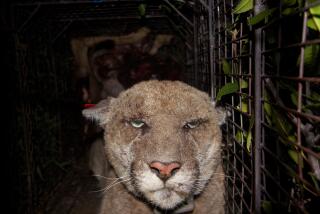Coyote Trapping Debate Continues : Wildlife: Animal regulation commission calls for further study in an attempt to reach a compromise.
- Share via
After a long, contentious hearing on a controversial nine-month ban on coyote trapping, the Los Angeles Animal Regulation Commission on Wednesday called for further study before deciding how to stop coyotes from foraging for food in residential areas.
The study is expected to seek a compromise that will appease wildlife conservationists, who oppose coyote trapping, and hillside residents--mostly in the west San Fernando Valley--who say trapping is needed to protect pets and children from coyote attacks.
The decision to ask animal regulation officials to draft recommendations within 60 days put an anticlimatic end to a meeting that was expected to finish the emotional debate over coyote trapping once and for all.
The study is expected to decide whether to continue a nine-month ban on coyote trapping despite an increase in coyote sightings in the urban foothill areas, a ban that will remain in effect in the meantime.
The decision came during a sometimes emotional meeting at Parkman Middle School in Woodland Hills attended by about 110 people, many of whom live in the hillside areas where coyote sightings have been on the rise.
“The memory of my little Kelly’s moans is more piercing than any yelp a coyote could make,” said Cathy Keen, mother of a 3-year-old girl killed by a coyote in Glendale in 1981.
Trapping--though painful to the animal--would make neighborhoods safer for children, Keen said.
“I’m not saying that trapping was a solution, but it kept the coyotes under control,” said Melvin Sumner, a longtime Woodland Hills resident.
Wildlife conservationists oppose trapping, saying the best way to keep coyotes out of urban neighborhoods is to cut off their food supply by keeping pets and pet food in at night, fencing yards and securing lids on trash cans.
“The need for coexistence is here,” said Martine Collette, operator of the Wildlife Waystation in the Angeles National Forest, which shelters injured and homeless wild animals. “The coyote will not go away.”
“The state supports the ban on trapping,” said Bob Schlichting, a spokesman for the state Fish and Game Department, drawing applause from the coyote-rights partisans. “The animals should be left alone.”
The trapping controversy began in June when the Animal Regulation Commission voted--partly in response to pressure from animal-rights advocates--to halt the trapping of coyotes by city employees. But the panel left residents the option of hiring a certified pest-control company to trap the animals.
By law, animal regulation officers must kill a coyote after it is trapped and are forbidden to relocate coyotes to other areas within the state.
Since trapping was banned, hillside residents, mostly in the West Valley, have complained of an increase in coyote sightings and attacks on pets. Michael Lazarous, a Woodland Hills resident, contends that his young son, a toddler, was stalked and nearly attacked in his back yard by a coyote. In one case, an animal regulation officer was forced to shoot to death a coyote stalking a small dog.
The increase in sightings and the storm of controversy over the ban prompted animal regulation officials to considering reviewing the policy. The commission met in Woodland Hills because most of the coyote complaints came from the West Valley.
Animal regulation officers attribute the increase in sightings to a combination of factors, including recent wildfires that drove coyotes into urban areas, the trapping ban and a seasonal abundance of the small wildlife that coyotes feed upon.
In light of the controversy, wildlife conservationists and hillside residents have offered a variety of solutions to the coyote problem.
A Cal State San Bernardino professor has suggested that the city feed coyotes food laced with a nontoxic salt to make the animals sick and discourage them from returning to a neighborhood.
More to Read
Sign up for Essential California
The most important California stories and recommendations in your inbox every morning.
You may occasionally receive promotional content from the Los Angeles Times.











